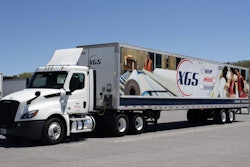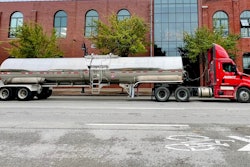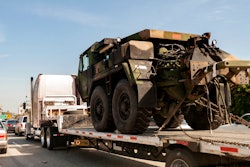Persistent demand weakness was evident in the third quarter financial results of most big fleets.
Old Dominion Freight Line (CCJ Top 250, No. 9) experienced significant volume declines, with revenue down 4.3% and LTL tons per day down 9% year over year. J.B. Hunt Transport, Inc., (No. 5) reported revenue was roughly flat year over year, with demand below normal seasonality for much of the quarter. Meanwhile, Schneider National (No. 6) experienced sub-seasonal performance, with softer volumes and retreating spot rates.
In addition to curbed demand, Old Dominion Chief Financial Officer Adam Satterfield pointed to weak manufacturing activity. The Institute for Supply Management’s Manufacturing PMI monthly readings have contracted in October for the eighth consecutive month, which Satterfield said had “obviously put pressure on everyone.”
October deterioration also dashed seasonal recovery hopes, the executives said in earnings calls. Satterfield explained that tonnage was down 5% versus September.
“That’s making that year-over-year change look a little bit worse," he said. "And we’ll see things progress through the quarter whether that changes or not.”
J.B. Hunt also saw challenging October trends. Spencer Frazier, executive vice president, commercial, noted that while ocean peak season came early, the inland supply chain dynamics were different. Customers continue to anticipate a peak season, though its magnitude and duration of peak volumes will differ.
Excess capacity
The downturn also left carriers with significant capacity, pushing tough decisions about capital deployment.
“I’d say we’re well north of the 30% at this point and probably even above 35% type of range,” Satterfield said, which had exceeded their target of 20% to 25% excess capacity.
Satterfield explained, “We do have several service centers that we’ve completed construction on … they’re ready to be turned into the operation. For that reason, we do start depreciating those facilities.”
Keeping service centers in reserve is a better approach, Satterfield said, as opening them would drive up line haul costs, and increase cost pressures.
He added that Old Dominion would lower its capital spending on real estate next year.
J.B. Hunt also carried excess capacity, with Darren Field, president of intermodal, commenting on container counts: “We have equipment that reaches useful life every quarter. It’s a small amount.”
Field noted that the company is making some decisions to retire some equipment given current demand levels.
Will regulatory enforcement reduce industry overcapacity?
Regulatory enforcement might begin to reduce industry capacity, according to some fleets.
J.B. Hunt COO Nick Hobbs noted that new regulations enforcement around English language proficiency, B1 visas, FMCSA biometric ID verification, and non-domiciled CDLs, are influencing available capacity. However, Hobbs said they don't expect to see any "material impact" on J.B. Hunt's capacity.
Hobbs linked Immigration and Customs Enforcement (ICE) activity to recent market tightening.
“That’s the reason you’ve seen spot rates up in the last couple of weeks. It’s been because of enforcement activity, and when you see the pockets, I would say it’s been able to cover freight; it’s just tightened it up, and so we’ve seen little tightness in probably eight to 10 markets, and I think you can kind of follow the news around and see where ICE is active and in big metropolitan areas," Hobbs said. "So it’s a combination of non-domicile. It’s also some cabotage. It’s also some fear factors."
Schneider saw similar dynamics, with president and CEO Mark Rourke noting, “Several new dynamics have been introduced over the last few months that are definitive catalysts for the removal of excess capacity after several years of expecting but not seeing more significant supply rationalization.”
This includes ELP regulations and the impact of non-domicile CDL renewals, he said.
Rourke noted that it “reflects self-regulation driven by the mere threat of enforcement.”
Additionally, Rourke said they’re seeing a rise of carrier bankruptcies, and the industry is now "approaching a year of Class 8 production below replacement levels, a trend that may accelerate given tariff dynamics.”
“We believe these have the potential to drive more supply rationalization than the impact we saw in 2017 from requiring electronic logging devices for hours-of-service enforcement,” Rourke added.
J.B. Hunt’s Frazier noted the industry’s cautious optimism: “While this industry may have a Chicken Little reputation when it comes to predicting capacity changes, the capacity bubble may be deflating as we speak."
Frazier cautioned that customers won't trust these predictions until they see tangible market tightness themselves.














